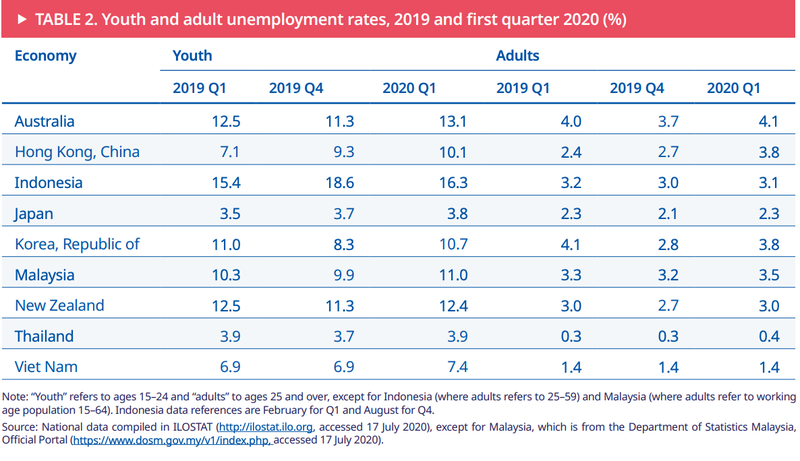Vietnam’s youth unemployment rate could soar to 13.2% on Covid-19
In Vietnam, the largest youth job losses are seen in the textile industry with 15% of total, followed by hospitality & catering services, and agriculture.
In a scenario where the Covid-19 may be contained within six months, the number of youth (15 – 24 years) in Vietnam losing their full-time jobs could be around 548,000, resulting in the youth unemployment rate of 13.2% in 2020.
Such a rate would nearly double the 6.9% rate recorded in2019, according to a new report from the Asian Development Bank (ADB) and the International Labor Organization (ILO).
In a 3-month containment scenario, the number of youth job losses is estimated at 370,000, equivalent to an unemployment rate of 10.8%.
The report, tilted “Tackling the Covid-19 youth employment crisis in Asia and the Pacific”, suggested the Covid-19 pandemic exerted greater impacts on the youth than adults (25 and older) in Asia, including Vietnam, resulting in higher longer-term economic and social costs.
Vietnam’s youth unemployment rate in the first quarter of 2020 was estimated at 7.4%, 0.5 percentage points higher than the similar rate recorded in the same period last year,
Meanwhile, the unemployment rate of adults in the January – March period remained unchanged at 1.4% against the first quarter of 2019.
The report listed seven sectors, out of 35, that accounted for 57.8% of total laid off young people in Vietnam. Among them, the largest terminations of employment are seen in the textile industry with 15%s, followed by hotels & restaurants with 13.6% and agriculture with 10.6%.
A survey from the General Statistics Office released in early July revealed that in the first six months, this year nearly 31 million workers aged 15 and over in Vietnam have been hit by the Covid-19 pandemic. Notably, 17.6 million people, or 57.3% of the affected ones, have received less income than before the Covid-19 outbreak.
The number of employed people aged 15 and over in the second quarter reached 53.1 million, down 2.2 million compared to the previous quarter and 2.4 million year-on-year, marking the sharpest plunge in the past decade.
Urgent measures required to generate jobs for youth
According to the report, one of the reasons young people in the region face greater unemployment risk and employment disruption than adults is that nearly half of them (more than 100 million) are employed in the four sectors hardest hit by the crisis: the wholesale and retail trade and repair; manufacturing; rental and business services; and accommodation and food services. Young women are overrepresented in three of the four most affected sectors, particularly in accommodation and food services.
The ILO-ADB report called on governments in the Asian region to adopt urgent, large-scale and targeted measures to generate jobs for youth, keep education and training on track, and to minimize future scarring of more than 660 million young people in the region.
The report cites three ways in which young people are affected in the current crisis: (1) job disruptions in the form of reduced working hours and earnings, and job losses for both paid workers and the self-employed; (2) disruptions in their education and training; and (3) difficulties in transitioning from school to work, and moving between jobs in a recession.
ILO-ADB collected data from nine economies, including Australia, Indonesia, Japan, Malaysia, Vietnam and Hong Kong (China), with the latter showing the largest increase of three percentage points in growth of the youth unemployment rate.



.png)










